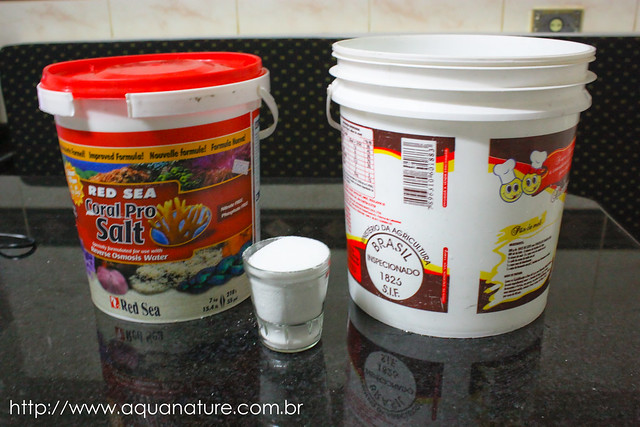Na minha opiniao na falta de testes laboratoriais, levar em consideracao a reputacao do fabricante, solubilidade do sal, preço e equivalencia de sua composicao proximo aos "niveis naturais", embora existam alguns sais aditivados com Calcio, Magnesio e Reserva alcalina mais elevados.
Mas não basta ter um bom sal se a água utilizada para rehidrata-lo seje de qualidade duvidosa, hoje em dia existem otimos filtros de DI ou RO ou mesmo uma combinacao de ambos para obter uma água de qualidade laboratorial ideal para o uso que pretendemos.

Outro item importante é a afericao da salinidade alcançada. Um hidrometro é um aparelho normalmente em plástico com uma agulha flutante com uma determinada escala, via de regra sao muito imprecisos e sensiveis a encrustracoes de sujeitas.

Hidrometros de vidro sao um pouco mais dificeis de encontrar e mais onerosos, mas mais precisos. O ideal na minha opiniao sao refratometros, devidamente calibrados.
Existe outro cuidado também na preparacao da mistura.... sempre adicionar primeiro a água e depois o sal, sempre nessa ordem, pois senao pode haver precipitacao de alguns elementos.
O armazenamento do sal não utilizado deve ser feito em local seco para não ocorrer empedramento. Quando o sal empedra, ocorre precipitaçao de carbonato de calcio CaCO3
http://archive.reefcentral.com/forums/s ... itate+salt
Solid Residues Remaining After Preparing Artificial Seawater
Most salt mixes leave behind a solid residue when dissolved, although the extent to which this occurs varies from brand to brand. I use Instant Ocean and rarely clean out the 44-gallon trashcan that I mix it in, so a significant residue builds up over time (Figure 1). In preparation for this article I removed some of this solid material, and found that it could be almost completely dissolved in hydrochloric acid with lots of bubbling. This demonstrates that these solids were probably calcium carbonate (CaCO3), perhaps also containing magnesium. Pure magnesium carbonate is undersaturated in seawater (which is detailed in later sections of this article) 1 and should dissolve in marine systems, so it isn't likely to be the precipitated material, although there may be significant magnesium in the calcium carbonate.
Based on the fact that the material exists as sheets that clearly did not arrive in the mix (as opposed to a fine powder which might have), I conclude that at least a significant fraction of this residue formed in the barrel. I cannot, however, rule out the possibility that some solid calcium or magnesium carbonate may have existed in the salt mix and was cemented together by additional precipitation of calcium carbonate during dissolution or storage.
When salt mixes are dissolved, there exist local regions where the salt concentration is very high. In those local regions, the calcium and alkalinity must also be very high. In fact, as seawater is concentrated by evaporation, there is a well-established series of minerals that precipitate as the salinity increases. In this series, calcium and magnesium carbonate are the first to precipitate, appearing at a specific gravity of about 1.140, which is about a 50% solution of salt in water.1 Such conditions may well exist on the bottom of a saltwater reservoir as the salt is dissolving.
With some mixes (but not the Instant Ocean that I use), the initial pH on dissolution may be very high (pH 8.5-9 +). As shown in detail later in this article, pH can play a dominant role in determining the rate of calcium carbonate precipitation, and such a high pH would make it more likely to precipitate.
t has been suggested by some aquarists that some salt mixes may contain anti-caking agents, such as clays. I do not know if this is true, but if it is, they may form part of the residue that is left behind after dissolution.
In order to minimize the formation of insoluble carbonate salts when mixing, the following suggestions may be helpful:
1. Add the salt to a full batch of water, rather than adding water slowly to a large batch of salt. The latter allows a greater time at much higher than natural seawater salinity, which may tend to precipitate calcium and magnesium salts.
2. Stir the mixture vigorously as it is being dissolved.
3. If using a mix with a high initial pH, aerate the mixture as well as stirring it. The aeration will reduce the pH.
http://www.reefkeeping.com/issues/2005-07/rhf/index.php


















